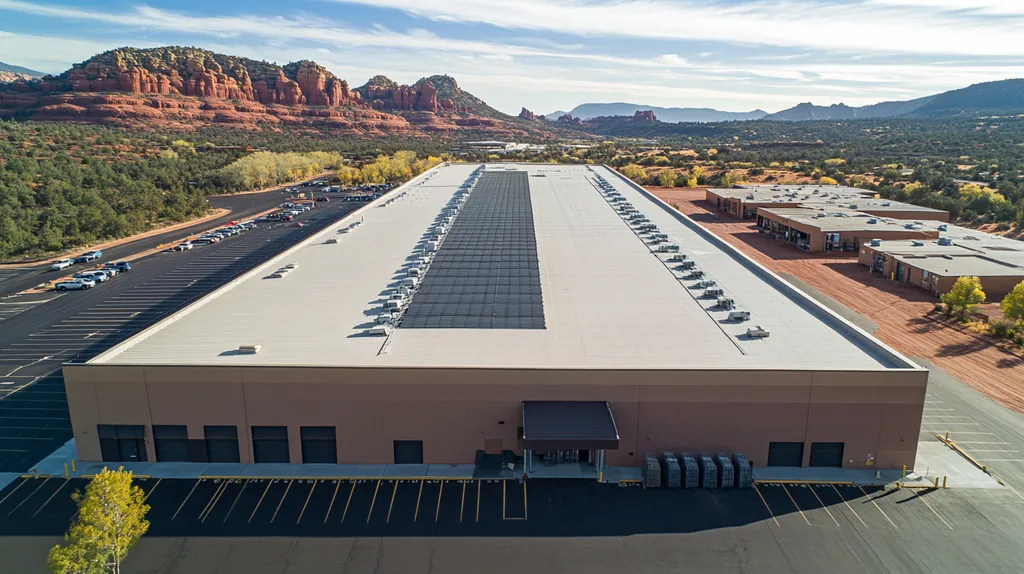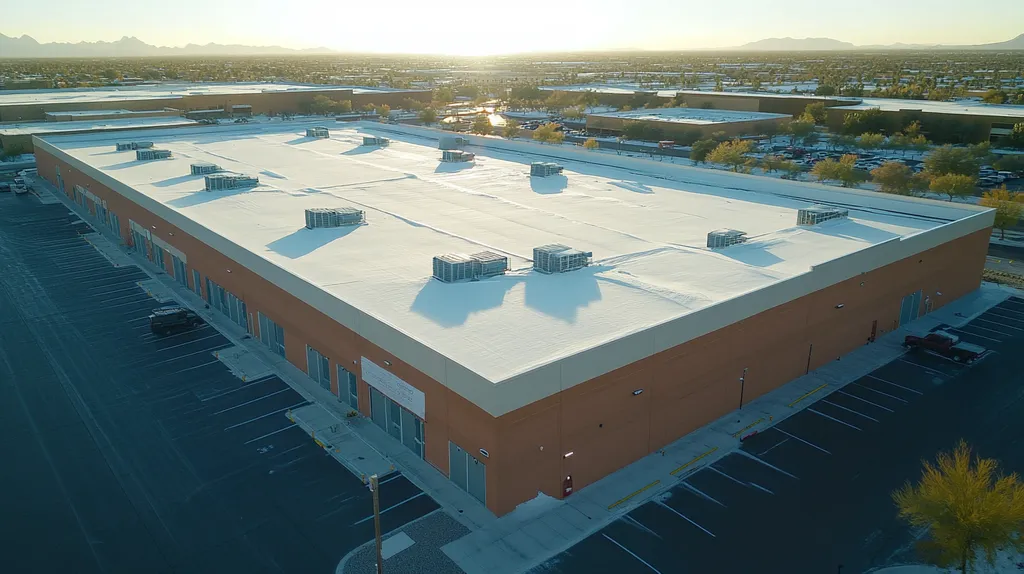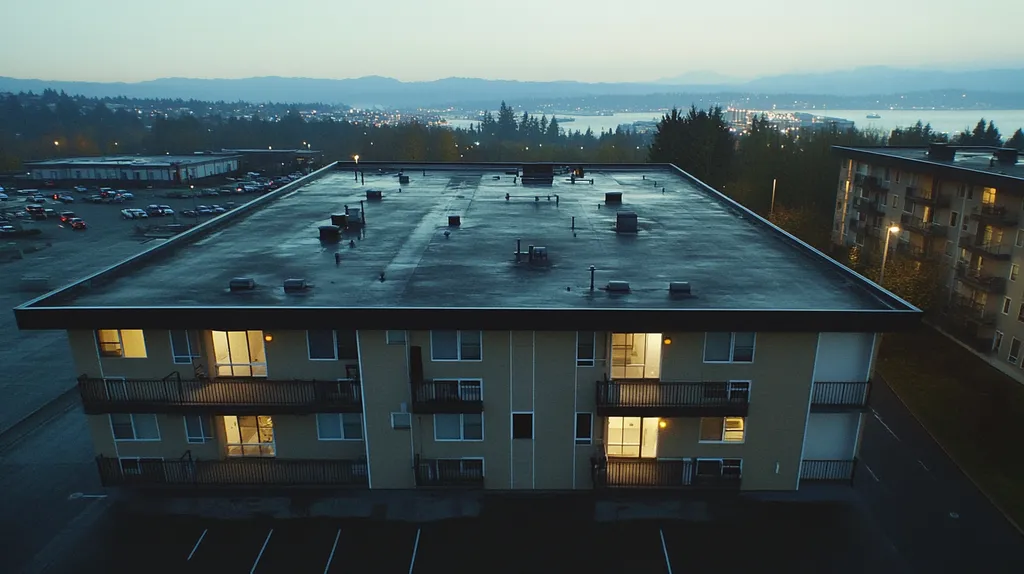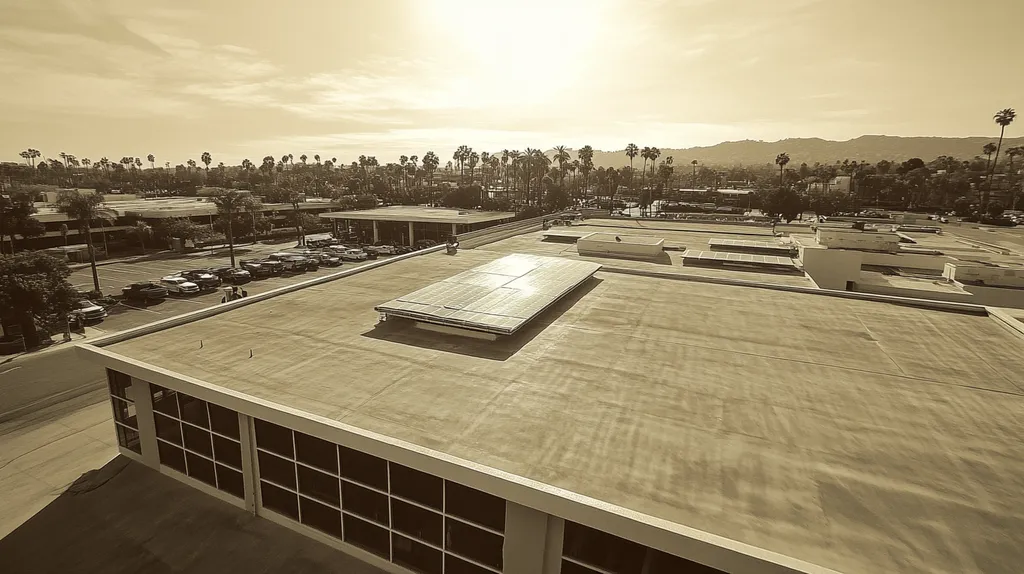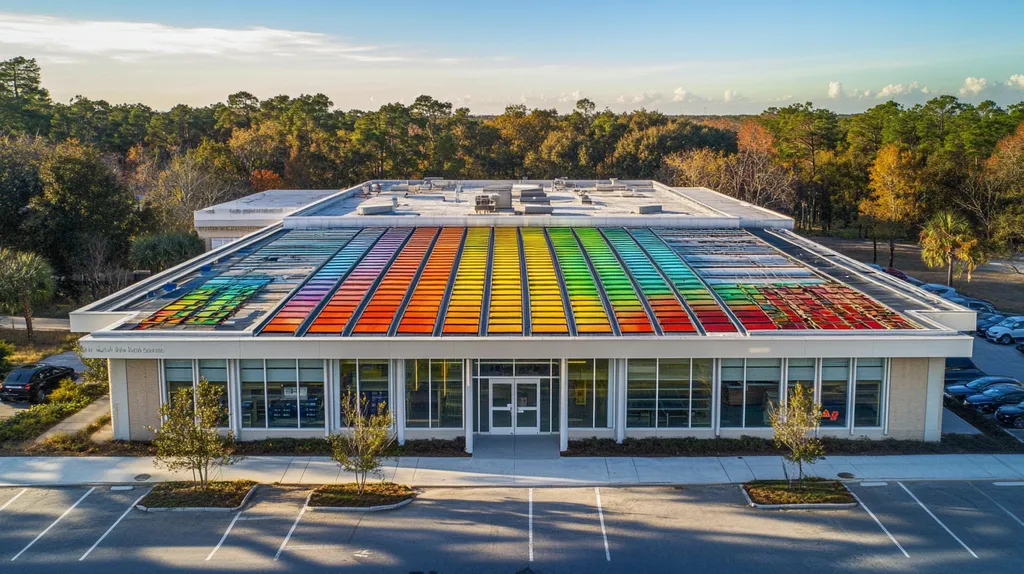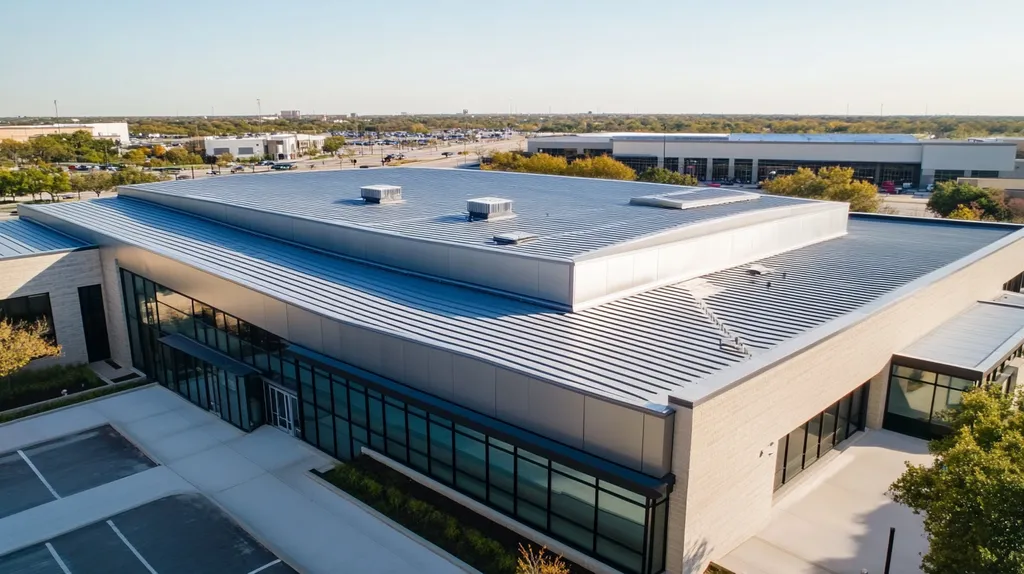With commercial buildings accounting for over 40% of global energy consumption, the environmental impact of roofing choices has never been more critical. Recent industry studies show that sustainable roofing solutions can reduce energy costs by up to 30% while significantly decreasing a building’s carbon footprint.
For property owners and facility managers, ensuring environmentally friendly roofing involves careful consideration of performance metrics, financial implications, and regulatory compliance. The decisions made today will impact both operational costs and environmental sustainability for decades to come.
This comprehensive guide explores essential factors in green roofing, from energy efficiency and material selection to risk management and long-term maintenance strategies, providing actionable solutions for sustainable commercial roofing projects.
SECTION 1: PERFORMANCE FACTORS
In the current commercial roofing landscape, the importance of making eco-friendly choices cannot be overstated. Buildings are responsible for over 40% of global energy consumption, meaning that roofing decisions carry weighty implications not just for individual sites, but for the environment as a whole. For property owners and facility managers, it’s essential to focus on energy efficiency, thermal insulation, and durability to ensure that roofing projects are both sustainable and cost-effective. This section explores the key performance factors that affect environmental impact and operational expenses.
Energy Efficiency Metrics
Energy efficiency stands as a cornerstone of sustainable roofing. A thoughtfully designed roof can lead to significant reductions in energy bills, with potential savings of up to 30%. Using reflective materials helps minimize heat absorption, especially during warmer months, reducing the heat strain on cooling systems.
Furthermore, adhering to energy codes and standards like ASHRAE 90.1 establishes vital benchmarks for energy performance. Compliance not only lowers energy usage but also enhances the property’s marketability, often leading to valuable incentives or rebates for those investing in compliant roofing solutions.
To optimize energy use, engaging energy auditors for modeling data can be instrumental. These experts can simulate energy consumption patterns and identify specific areas for improvement, ensuring informed decision-making that promotes substantial long-term savings.
Additionally, incorporating renewable energy options, such as solar panels, can boost overall efficiency while advancing sustainability objectives. Designing buildings that accommodate these technologies is increasingly essential for businesses looking to future-proof their investments.
Key Action Items
Thermal Insulation and Comfort
Effective thermal insulation is key to keeping indoor environments comfortable throughout the year. Inadequate insulation can cause temperature swings, leading to higher energy bills. A roof designed for high thermal performance helps stabilize heating and cooling costs.
Property owners should look for materials with a high R-value, signaling superior insulation capabilities. Options like spray foam and mineral wool can notably enhance a roof’s thermal efficiency, boosting comfort while extending the roof’s lifespan.
Proper ventilation is also critical for preventing heat buildup. Roofs without adequate airflow are prone to moisture, which can result in mold and structural damage. Evaluating ventilation systems during the roofing project is essential for effective thermal management.
Ultimately, prioritizing thermal insulation not only improves occupant comfort but also creates a healthier indoor environment. This consideration can have lasting benefits for employee productivity and overall satisfaction.
Key Action Items
Durability and Maintenance Needs
The durability of roofing materials plays a major role in determining how often maintenance is required. Selecting quality materials initially can yield longer-lasting solutions that reduce the frequency of repairs. For example, TPO and PVC membranes are highly regarded for their durability and resistance to UV degradation.
Establishing regular maintenance schedules is essential for extending roof lifespan. Property managers should perform routine inspections to catch potential issues early. Addressing minor leaks promptly can prevent costly water damage and extensive repairs later on.
Selecting low-maintenance materials further strengthens sustainable practices. Roofs that need less frequent replacement contribute less waste to landfills and promote eco-friendly initiatives. Partnering with reliable roofing contractors for inspections and repairs can help optimize long-term building performance.
In summary, concentrating on durable roofing systems and proactive maintenance not only secures future investments but also reinforces sustainability commitments. This strategic approach can yield financial benefits while reducing the overall environmental impact of commercial properties.
Key Action Items
SECTION 2: FINANCIAL CONSIDERATIONS
Navigating the financial landscape of commercial roofing can be daunting for property owners and facility managers. While the upfront investment in environmentally friendly roofing solutions may appear overwhelming, the long-term financial benefits and potential increase in property value make these choices worthwhile. A clear understanding of financial factors is essential for informed decision-making that aligns with sustainable roofing goals.
Initial Investment and Cost Analysis
Investing in an environmentally friendly roof typically demands a higher upfront cost compared to conventional options. While materials such as green roofs, solar panels, or metal systems might seem pricier at the outset, they offer considerable advantages over time. Conducting a detailed cost analysis helps property owners weigh these options effectively.
It’s also vital to consider the lifespan of materials when making decisions. A TPO roof may last around 20 years at a lower initial cost, whereas a metal roof can provide durability for about 50 years with a larger investment. A thorough evaluation of life-cycle costs presents a more comprehensive financial perspective.
Installation expenses can vary as well. Eco-friendly roofs often require specialized installation skills, impacting labor costs. Obtaining quotes from multiple contractors can help ensure competitive pricing and budget-friendly options.
Key Action Items
Long-Term Cost Savings and ROI
Opting for an environmentally friendly roof can lead to significant long-term savings. These roofs typically require less energy for heating and cooling, resulting in lower utility bills and maintenance costs over time. For example, a reflective roof can cut energy consumption by as much as 20%.
Research indicates that buildings equipped with sustainable roofing often enjoy higher resale values. This factor positions eco-friendly roofs not just as a cost-saving measure, but as a valuable long-term investment. Owners can potentially recover a large portion of their expenses through increased property worth.
Sustainable features also enhance tenant retention rates. Businesses increasingly seek environmentally responsible spaces, making these properties attractive to prospective tenants. A steady tenant base generates reliable income for property owners.
Key Action Items
Tax Incentives and Rebates
Many cities and states offer tax incentives and rebates for eco-friendly building projects, which can significantly help reduce initial costs associated with commercial roof installations. Property owners should actively seek out available programs in their locality.
For instance, the federal Investment Tax Credit allows for a portion of solar panel installation expenses to be deducted from federal taxes. Additionally, state and local programs may provide valuable rebates for green roofing initiatives. These incentives can accelerate the return on investment.
Grants specifically for sustainable construction may also exist, aiming to encourage energy-efficient building practices. Exploring these opportunities could yield beneficial financial support for your projects.
Collaborating with financial advisors to identify and capitalize on potential incentives can lead to considerable savings while reinforcing your sustainability initiatives.
Key Action Items
SECTION 3: COMPLIANCE REQUIREMENTS
As commercial property owners and facility managers shift their focus toward sustainability, understanding compliance requirements becomes crucial. Meeting these standards is not just about good intentions; it’s essential to avoid hefty fines, project delays, and damage to a company’s reputation. From green building certifications to local and federal regulations, navigating these critical areas will pave the way for successful and environmentally friendly roofing projects.
Green Building Certifications (LEED, etc.)
Green building certifications like LEED (Leadership in Energy and Environmental Design) are increasingly important for commercial roofing initiatives. These certifications demand adherence to strict standards for materials and energy efficiency, signaling a serious commitment to sustainability that can also enhance property value and marketability.
LEED certifications come in various tiers—Certified, Silver, Gold, and Platinum—each representing a different level of eco-consciousness. To achieve these designations, projects must earn points across categories, such as sustainable site development and material selection. This framework not only validates a project’s environmental benefits but also helps property owners attract eco-aware tenants.
Choosing roofing materials that contribute to LEED credits is essential and can significantly elevate a project’s sustainability profile. Although the process to achieve these certifications may appear daunting, the long-term benefits—such as reduced operational costs and increased attraction to eco-conscious tenants—make it well worth the effort.
Key Action Items
Local and Federal Environmental Regulations
Understanding and adhering to local and federal environmental regulations is critical for any commercial roofing project. These regulations typically govern key aspects such as stormwater management, air quality, and the proper handling of hazardous materials. For instance, property owners may need permits for compliance with the Clean Water Act regarding roof runoff management.
Local laws can vary significantly from one area to another, and non-compliance can result in financial penalties or even project shutdowns. Facility managers should actively engage with local government or environmental agencies to ensure their roofing projects meet current regulatory standards.
Moreover, a growing focus on minimizing carbon emissions from roofing installations and maintenance is emerging. Understanding these requirements not only keeps property owners in line with regulations but also supports broader environmental objectives that benefit the community.
Key Action Items
Industry Standards for Sustainable Materials
Utilizing sustainable materials is foundational for crafting environmentally friendly roofs. Industry standards like the Cradle to Cradle Certification outline criteria for material use, encompassing environmental, social, and economic considerations. By aligning with these standards, property owners ensure that the roofing materials they select are both eco-conscious and responsibly sourced.
Examples of sustainable roofing materials include recycled shingles, metal roofing, and green roofs featuring live vegetation. Each option presents unique ecological benefits, such as improved energy efficiency and effective stormwater management. Choosing materials that meet these standards not only assists with compliance but boosts the overall sustainability profile of a building.
Facility managers should conduct thorough due diligence when sourcing materials, verifying supplier certifications to confirm environmental claims. Partnering with suppliers who emphasize sustainability makes it easier to adhere to compliance requirements and fosters a commitment to eco-friendly building practices.
Key Action Items
SECTION 4: RISK MANAGEMENT
As the impacts of climate change increasingly shape construction practices, effective risk management in roofing projects rises to the forefront. A notable 2020 study found that a staggering 70% of property owners faced costly delays due to insufficient environmental assessments. By actively managing risks, property owners not only protect their financial investments but also enhance their sustainability efforts. This section covers three critical areas: environmental impact assessments, the risks related to material sourcing and supply chains, and strategies for weather and climate change mitigation.
Environmental Impact Assessment
Undertaking an environmental impact assessment (EIA) is pivotal for any roofing project. This evaluation measures how the project’s execution impacts local ecosystems, resources, and the surrounding community. By pinpointing potential threats to air quality, water resources, and local biodiversity, property owners can avoid regulatory fines and negative public perception.
Additionally, a detailed assessment can reveal pathways to more sustainable practices. For instance, a roofing project emphasizing energy efficiency may ultimately decrease ongoing operational expenses. Failing to perform an EIA can lead to project delays as stakeholders demand adherence to regulatory standards.
When collaborating with roofing contractors, inquiring about their EIA capabilities is essential. Those with expertise in sustainable practices can assist property owners in navigating compliance requirements while identifying areas for improvement. A well-informed property owner can make choices that lessen environmental impact and enhance financial outcomes.
Key Action Items
Material Sourcing and Supply Chain Risks
The sourcing of materials poses significant risks in commercial roofing projects. As the demand for sustainable materials rises, not all suppliers adhere to environmental standards. This can lead to inconsistencies in quality, unethical production practices, and harm to the environment from irresponsible sourcing.
Choosing materials that are sustainably sourced helps minimize both operational and reputational risks. For example, opting for recycled materials not only cuts down on waste but also reflects corporate social responsibility. Property owners should seek transparency from suppliers regarding their environmental and manufacturing processes.
With global supply chain disruptions on the rise, having a contingency plan becomes increasingly important. Diversifying suppliers or investing in local sources can mitigate risks associated with dependency on a single vendor. This strategy not only benefits the local economy but also tends to offer faster delivery times.
Key Action Items
Weather and Climate Change Mitigation
Extreme weather events pose substantial risks to roofing projects. These disruptions can lead to construction delays, increased expenses, and potential safety hazards. Taking a proactive approach to climate change involves selecting materials and designs that are resilient to severe conditions.
For instance, reflective roofing materials can dramatically lower heat absorption, reducing energy costs and enhancing indoor comfort. Also, effective drainage systems can minimize water accumulation, decreasing the likelihood of leaks and subsequent structural harm. By taking local climate patterns into account, property owners can design roofs that are built to withstand extreme weather.
Utilizing predictive analytics tools can also help anticipate disruptions before they impact projects. These tools can analyze historical weather data and forecast future events, leading to better-informed decision-making. Such foresight significantly reduces risks associated with unpredictable climate shifts.
Key Action Items
SECTION 5: OPERATIONAL PROCEDURES
To ensure an environmentally friendly roofing project, implementing effective operational procedures is vital. Statistics reveal that construction and maintenance practices in the roofing industry contribute significantly to waste and pollution. By adopting proactive strategies, property owners and facility managers can enhance sustainability and lower ecological footprints. This section unveils critical installation and maintenance protocols, waste reduction practices, and necessary employee training guidelines to meet green roofing goals.
Installation and Maintenance Protocols
Proper installation and ongoing maintenance of roofs are fundamental for achieving sustainability. Using energy-efficient materials, such as reflective roofing, can significantly decrease a building’s energy consumption by lowering heat absorption. This leads to reduced cooling costs and minimized greenhouse gas emissions.
Regular maintenance is critical for extending the lifespan of roofing systems. Scheduled inspections and timely repairs can prevent leaks and other damages that could necessitate costly re-roofing projects. This proactive approach not only saves money but also reduces material waste associated with premature replacements.
Choose roofing contractors who practice environmentally sound methods during installation, such as utilizing low-VOC adhesives and recyclable materials. A commitment to sustainable installation ensures a resilient and eco-friendly roofing system.
Key Action Items
Waste Reduction and Recycling Practices
The roofing industry generates substantial waste, primarily from discarded materials during installation and replacement. Implementing waste reduction strategies can significantly mitigate this problem. For example, using deconstruction methods allows for recycling of old roofing materials instead of sending them to landfills.
Collaborating with suppliers who offer recyclable materials and encourage take-back programs is essential. Items like flashing, tiles, and underlayment can often be recycled, thus reducing overall waste. Engaging contractors who prioritize waste minimization enhances eco-friendliness.
Additionally, adopting a construction waste management plan outlining specific recycling targets and strategies for waste segregation at the job site is recommended. Efficient tracking of waste materials is vital to achieving recycling goals.
Key Action Items
Employee Training and Safety Guidelines
Training employees on sustainable roofing practices is essential for the successful implementation of green initiatives. Workers must be knowledgeable about the environmental impacts associated with materials and methods, ensuring they understand the importance of minimizing waste and utilizing recyclable products.
Safety protocols are equally vital in operational procedures. Comprehensive training programs should cover material handling and the safe disposal of hazardous waste to foster a safe work environment. Prioritizing safety reduces accidents while promoting a culture of sustainability.
Encouraging continuous education about evolving sustainable practices within the industry fosters innovation. Hosting workshops or training sessions on new technologies empowers employees to actively contribute to a greener roofing future.
Key Action Items
SECTION 5: OPERATIONAL PROCEDURES
Implementing effective operational procedures is crucial for ensuring an environmentally friendly roof project. Construction and maintenance practices in the roofing industry can generate significant waste and pollution. By adopting proactive strategies, property owners and facility managers can promote sustainability and reduce their ecological footprints. This section highlights essential installation and maintenance protocols, waste reduction techniques, and necessary employee training guidelines to achieve green roofing goals.
Installation and Maintenance Protocols
Successful sustainability starts with proper roof installation and maintenance. Using energy-efficient materials, such as reflective roofing, can dramatically reduce energy consumption—leading to lower cooling costs and fewer greenhouse gas emissions.
Regular maintenance is key for extending the lifespan of roofing systems. Scheduled inspections and prompt repairs can prevent leaks and damages that might lead to costly re-roofing projects. This proactive stance saves money and reduces material waste associated with premature replacements.
Select roofing contractors who prioritize environmentally responsible practices during installation. This includes using low-VOC adhesives and recyclable materials whenever possible. An emphasis on sustainable installation ensures a durable and eco-friendly roofing system.
Finally, establish a reliable maintenance schedule and adhere to manufacturer guidelines for optimal performance. Effective maintenance programs should include thorough documentation of repairs and inspections to track environmental efficiency over time.
Key Action Items
Waste Reduction and Recycling Practices
The roofing industry produces considerable waste, primarily from discarded materials during installation and replacement. Implementing effective waste reduction strategies can help mitigate this issue. For example, utilizing deconstruction methods allows for the recycling of old roofing materials instead of sending them to landfills.
Partnering with suppliers who provide recyclable materials and support take-back programs is vital. Items like flashing, tiles, and underlayment can often be recycled, helping to lower overall waste. Engaging contractors committed to minimizing waste enhances your project’s eco-friendliness.
Additionally, create a construction waste management plan detailing specific recycling targets and strategies for waste segregation at job sites. Efficiently tracking waste materials is essential to achieving these goals.
Utilizing local recycling services can further bolster sustainability initiatives. Reducing unnecessary transportation of waste not only cuts costs but also decreases carbon emissions, fostering environmentally responsible practices.
Key Action Items
Employee Training and Safety Guidelines
Training employees on sustainable roofing practices is essential for successfully implementing green initiatives. Workers should comprehend the environmental impacts of materials and methods, fostering an understanding of the importance of minimizing waste and using recyclable products.
Safety protocols are equally important in operational procedures. This includes comprehensive training programs covering proper material handling and safe disposal of hazardous waste. Prioritizing safety can reduce accidents while reinforcing a culture of sustainability.
Encouraging continuous education on evolving sustainable practices fosters innovation. Hosting workshops or training sessions on new technologies empowers employees to play an active role in promoting a greener roofing future.
Finally, recognize and reward sustainable initiatives among employees. Acknowledging their contributions reinforces the importance of eco-friendly practices and fosters ongoing commitment to the organization’s sustainability goals.
Key Action Items
The Bottom Line
With commercial buildings responsible for over 40% of global energy consumption, the implementation of sustainable roofing has become an environmental and economic imperative.
The adoption of eco-friendly roofing solutions can reduce energy costs by up to 30% while significantly decreasing a building’s carbon footprint.
Success requires careful attention to performance metrics, financial planning, regulatory compliance, and risk management strategies.
Property owners and facility managers who invest in sustainable roofing practices today position themselves advantageously for increasingly stringent environmental regulations and rising energy costs.
By following established protocols for installation, maintenance, and waste reduction, organizations can achieve both environmental responsibility and substantial cost savings over their roofing system’s lifecycle.
FREQUENTLY ASKED QUESTIONS
Q. What performance factors should I consider for a commercial roof?
A. Key performance factors for commercial roofs include energy efficiency, thermal insulation, and durability. Choosing materials that enhance energy efficiency can significantly lower cooling bills, while robust insulation helps maintain comfortable indoor temperatures. Investing in durable materials reduces maintenance needs over time, ultimately delivering cost-effective roofing solutions.
Q. How can I analyze costs for an industrial roof project?
A. To analyze costs effectively, compare the initial investment for different roofing options, including eco-friendly choices. Evaluate the lifespan and replacement costs of various materials. Request quotes from multiple contractors to assess installation costs and consider future maintenance expenses in your overall budget analysis for informed decision-making.
Q. What compliance requirements exist for a commercial roof?
A. Compliance requirements for commercial roofs often include obtaining necessary permits and adhering to local and federal regulations. It’s crucial to understand green building certifications and environmental regulations, such as stormwater management standards. Failing to meet these requirements can lead to fines, project delays, or a damaged reputation.
Q. How do I manage risks in an industrial roof project?
A. To manage risks effectively, conduct thorough environmental impact assessments before starting a roofing project. Address material sourcing risks by verifying sustainability credentials of suppliers. Additionally, prepare for weather-related disruptions by utilizing resilient materials and implementing effective drainage systems to minimize potential damages and delays.
Q. What operational procedures ensure sustainable roofing practices?
A. Effective operational procedures should include scheduled inspections, prompt repairs, and the use of energy-efficient materials. Engage contractors who use low-VOC adhesives and recyclable materials. Implement waste reduction strategies like recycling or reusing materials during installation to promote sustainability while monitoring waste diversion rates regularly.
Q. How can employee training improve roofing sustainability?
A. Training employees on sustainable roofing practices is crucial for effective implementation. Workers should understand the environmental impact of materials and methods. Safety training is equally important, covering proper material handling and disposal. Regular workshops on new technologies foster innovation and ensure employees contribute to sustainability goals in roofing projects.
Q. What are effective waste reduction practices for commercial roofs?
A. To reduce waste, implement a construction waste management plan detailing recycling targets. Utilize deconstruction methods to recycle old materials rather than disposing of them in landfills. Collaborate with suppliers to source recyclable materials and train staff on waste segregation practices to enhance sustainability throughout the roofing process.

